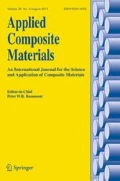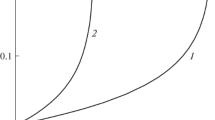Abstract
A mathematical model of the formation and failure of a hard skeleton in sintered composites with a high content of high-melting filler is presented. On the basis of an analysis of joining particles in sintering the characteristics of the structure of composites (in particular, a connectivity and contiguity of skeleton) are determined. A mathematical model of skeleton failure which is based on the theories of percolation and reliability is developed. The influence of the characteristics of the composite structure on the strength of composite is studied.
Similar content being viewed by others
References
Kisly P.S. et al.Physical and Chemical Foundations of Production of High-melting Superhard Materials. Naukova Dumka, Kiev, 1986 (in Russian).
Kreimer G.S.Strength of Hard Alloys. Consultants Bureau, New York, 1968.
Exner H.E. and Gurland J., ‘A Review of Parameters Influencing Some Mechanical Properties of Tungsten Carbide-Cobalt Alloys’.Powder Metallurgy. Vol. 13, No. 20, pp. 13–31, 1970.
Chermant J.L. and Osterstock F., ‘Elastic and Plastic Characteristics of WC-Co Composite Materials’.Powder Met. Int. 11 No. 3, 106–109, 1979.
Loshak M.G.,Strength and Durability of Hard ALloys. Naukova Dumka, Kiev, 1984.
Kingery W.D.,Introduction into Ceramics. Wiley, New York, 1960.
Korn G.A. and Korn T.M.Mathematical Handbook for Scientists and Engineers, McGraw Hill, New York, 1968.
Gegusin Ya. Ye.,Physics of Sintering. Nauka, Moscow, 1967 (in Russian).
Stauffer D.,Introduction into Percolation Theory. Taylor and Francis, 1985.
Mishnaevsky, Jr. L.L., ‘Informational Model of Rock Destruction and the Principle of Mining Tool Improvement’. InFracture and Damage in Concrete and Rock, in H.P. Rossmanith (ed.), FDCR-2, 1992, Vienna. E&F Spon, London, pp. 393–398, 1993.
Brook R.H.W.,Reliability Concepts in Engineering. Butterworts, London, 1972.
Zhurkov S.N. ‘Kinetic Concept of the Strength of Solids’.Int. J. Fracture Mech. 1, No. 4, 1965.
Timoshenko S.P. and Goodier J.N.Theory of Elasticity. McGraw Hill, New York, 1970.
Author information
Authors and Affiliations
Rights and permissions
About this article
Cite this article
Mishnaevsky, L.L. A new approach to the analysis of strength of a matrix composite with a high content of hard filler. Appl Compos Mater 1, 317–324 (1994). https://doi.org/10.1007/BF00568287
Received:
Accepted:
Issue Date:
DOI: https://doi.org/10.1007/BF00568287




